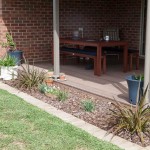So, here is my much delayed part 2 discussion on our simple living plans, and how we, by cunning plan and design, save money as well as the environment by reducing our use of power and water.
It involves things from the very basics – turning lights off when not in use, changing globes over to compact flourescent. We learnt long ago how power and wattage work, and by judicious use and planning, you can run multiple lights for very little money. For example, the main 2 lights in the family room/kitchen, 3 pendant lights for over the bench task lighting, as well as an overhead light in the kitchen…. grand total of 48 watts. Which means at night we have all the light we need for the needs of our growing family – eating, cooking, cleaning up, relaxing, for as long as we need for very little money. Which seems pathetically obsessed with saving cents, however, they do add up, night after night, over the course of a year. Those same 6 lights, when we first moved into this house, had 42 watt globes in them EACH. So we have, the equivalent of nearly 5 lights now running for nothing, just by putting in the new globes. Multiply that by all the lights that a busy family uses in an evening, bedrooms, toilets, pantry etc, and the savings become significant. And where you are saving watts, not only are you saving money but you are saving energy which is better for the environment.
Hot water is a big power user. Of course, we aren’t going to do without it just now, sorry, but we put a lot of thought into how we are going to get it when we were planning our new home. Old-fashioned electric hot water services are no longer permitted on new houses, and up here we don’t have the luxury of natural gas piped to the house, so gas hot water becomes a very unattractive option. Mainly because you need to use bottled LPG for any gas needs (like a giant bbq bottle), at a minimum of $100 a bottle refill. Which, depending on your hot water usage, can last as little as 6 weeks, up to stretching it out to 12. PLUS the gas companies charge you rental for the privilege of using their bottles, so you are looking at well over $400 minimum a year for your hot water costs.
Other alternatives are Solar Power and something that is still relatively uncommon in Australia, which is Heat Pump Electric. Both of these offerings from our builder were, in our researched opinions, lesser quality options, so we decided to have our own system installed post hand-over – a Siddon’s Solar Stream Heat pump system. Cheaper by far than gas to run, and we weren’t convinced of the benefits of solar in comparison – we would need frost rated panels, and I would rather save up our roof space for a solar power installation down the track. We have had only one bill since we moved in, but the off-peak electricity for 2 months of hot water in summer cost us approximately $20. Can’t beat that.
You can see the tank, and the compressor (wall-mounted) here at the back of the house. Sits neatly above the air-conditioner compressor and between the 2 bedroom windows.
So yes, our big dirty secret is that this house has ducted air-conditioning. However, that is not as expensive a decision as you may think. Again, because of no access to natural gas, it means that gas wall heaters etc are unbelievably expensive due to the price of the LPG bottles. We have had a slow combustion fire in our last house for 3 winters, and the work required, as well as the price of wood, finding somewhere in the yard to store wood (and the critters that live among it) and the ash and dust they produce inside, it’s not that attractive an option. We did consider Heat Bank storage heaters, however they would have been difficult to install during the build, and for the price to buy, they weren’t a cheaper option. They also require substantial amounts of wall mounting space, when that area for storage was at a premium, to keep the house small and costs down.
We had our airconditioning designed by an engineer (not a salesman), who understood how to make them energy efficient. We selected a super efficient model of compressor and head unit, with enough power for the area we are trying to heat/cool without making the compressor work over-time and subsequently, cost more to run. We even upgraded the ducting to a special “green” version, which keeps in more heat/cold from the air than regular ducting. With a clever digital controller, on/off timers, and well planned zones, we find that this baby will heat the entire house in only a couple of hours, making it super efficient for the price it may cost to run it. My focus is on heating, up here you might need to cool maybe 10 times in all of summer? But heating will be every night in the middle of winter. AND as an added bonus, having the heating on helps me dry clothes without having to have a clothes dryer. Double bonus!
You can see the massive thick insulation batts (R6) and the super green ducting here in this shot. Also notice the sarking above, directly under the roofing iron. Not a huge amount of insulation property, but every bit counts.
You don’t need me to tell you about how to isolate power vampires, turning things off instead of standby etc. That’s been promoted enough, and to be honest, we often don’t bother with it. It’s next on my list for the family.
As far as water goes, it’s more of a “if only I had” than what we ARE doing. Legislation required us to install a 1000l Rainwater tank hooked up to at least 1 toilet. This was an extra expense, as a pump is also required for the pressure from the tank. I saw it as more of an imposition than a chance to really make a difference. However, with a 10,000L tank now installed, and already full before the start of winter, I am regretting not factoring more rainwater use in the house. At the very least, we should have plumbed in a tap in the laundry, which would have been straight through the wall to the toilet already connected. It would have been smart to hook the second toilet up to the tank as well. But even so, whenever we use our main toilet, the water we use to flush it is free.
Other water saving measures included choosing all tapware and sanitary ware with an eye for the water rating. Our shower heads are all 3 star rated, at 9L a min. Our kitchen mixer tap is a 4star 7.5L a min tap. The cisterns we selected have again a 4star rating, using 4.5L/3L dual flush. That is a major saving over a year of water consumption. We have a super-efficient Miele washing machine in the laundry, which uses a phenomenally small amount of water. Yes it did cost a lot more to buy, but in the long run, it saves us money, and it saves the environment. Water is becoming a major issue in Australia, as we are suffering from the damage done to our natural weather systems with increasing spells of drought in some areas, followed by devastating floods.
So whatever small savings we can make, in our usage and drain on the environment of precious energy and water resources, I consider it a win for all the community, as well as my budget. I’m sure that you all feel the same way too. What else do you do to save yourself as well as the planet in these areas? I’d love to gather some more ideas for people!
Please be aware that there may be affiliate links in this content. Your support allows me to keep creating for you!






Jenny
Where I live the heater is rarely turned on, but the Air Conditioner is a must have. I have mine set on a timer so that it gets warmer during the day when we are all gone and cools off at night when we’re about to get home. My programmable thermostat has saved us a lot of energy and money. That and extra insulation have really made the difference in our energy consumption.
While I was at the hardware store this weekend I saw little water tanks that are designed to catch rain to use in the garden area. I really thought of getting one, but they are rather expensive and we are about to head into the dry season. Probably won’t do that till the fall.
magginoodles
It’s definitely been worth it. The extra water would have been nice but we do live in the hills, it does rain a bit up here 🙂
Reviewing the frugal budget | Hands, Heart, Passion
[…] So, I have previously rambled on a bit about how we manage our budget, living simply and making sure that we put our money to best use. Here – Simple living but not the simple life, and also here, in Frugal by design Part 2. […]